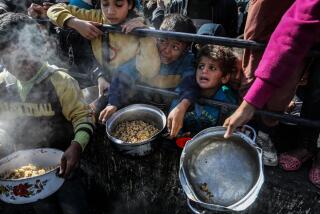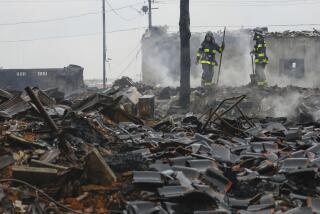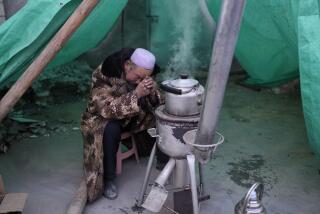Survivors Sought as Turkey Quake Toll Hits 2,000
- Share via
IZMIT, Turkey — Rescue teams worked furiously into the early morning hours today looking for survivors of a massive earthquake that rolled across Turkey’s industrial heartland, killing more than 2,000 people, injuring at least 10,000 and overwhelming hospitals with corpses and dazed, bloodied survivors.
The magnitude 7.8 quake struck at 3:02 a.m. local time Tuesday in the region just east of the country’s major city, Istanbul, felling hundreds of residential buildings--many, the government acknowledged, made of substandard materials. The debris crushed or smothered most of the victims in their sleep. By the end of the first day, thousands were still missing.
The temblor and its aftershocks killed at least 160 sailors at a Turkish naval base; set an oil refinery ablaze; disrupted water and power supplies; flattened overpasses and caused collisions on the highway linking Istanbul with Ankara, the capital; toppled mosques and minarets in this mostly Islamic nation; wrecked workplaces; and left tens of thousands homeless in a string of smokestack communities along the Sea of Marmara.
“The loss is huge,” Prime Minister Bulent Ecevit said Tuesday in a trembling voice while touring the damaged area. “May Allah help our state and our people.”
Ecevit’s government appealed for search dogs, field hospitals, ambulances and other technical help to find and treat victims of what was believed to be the Istanbul region’s deadliest quake, but said Turkey had enough resources to feed and shelter them.
Rescue teams arrived or were en route from the United States, France, Germany, Switzerland, Japan and Israel.
In Washington, President Clinton dispatched a search and rescue team from the Agency for International Development, along with a separate disaster relief coordination team. He also released a grant of $25,000 for the Turkish Red Crescent, affiliated with the International Committee of the Red Cross. White House officials said there had been no reports of damage to U.S. military operations in Turkey.
“Our thoughts and prayers are with the victims and their families,” Clinton said in Washington. “Turkey has been our friend and ally for a long time now. We must stand with them and do whatever we can to help them get through this terrible crisis.”
The temblor struck Turkey’s most densely populated area--the Istanbul metropolitan region of about 10 million people--and scores of cities and towns to the east. Turkish officials measured the quake at magnitude 6.7; the U.S. Geological Survey in Golden, Colo., gave 7.8 as the average reading of its many monitoring instruments, though American specialists said that figure might change slightly today when fresh calculations are made.
Energy Secretary Bill Richardson, in Istanbul for talks on oil and gas pipeline projects, called the quake a frightening “45 seconds worth of very violent shaking.”
“It was like Judgment Day,” recalled Veysi Savur, a middle-aged man in Izmit, who wore a blood-soaked Calvin Klein T-shirt around his head. “There was this deep and long shudder. The ceiling became the ground, the ground the ceiling. I thought I was dead.”
Izmit, an industrial city of about 500,000 people located 65 miles east of Istanbul, was nearest the epicenter.
The city’s oil refinery, run by the state-owned Tupras company, caught fire and defied daylong efforts from land and sea by firefighters to extinguish the blaze. Two Turkish navy buildings collapsed in the nearby Marmara seaport of Golcuk, killing sailors in their sleep at one of the navy’s main bases.
Turkish state television said more than 500 people were killed in the city of Adapazari, 80 miles east of Istanbul; at least 260 in Golcuk, southwest of the epicenter; and at least 165 in Istanbul. The government said it knew of no foreigners being injured and of no damage to historical sites in Istanbul such as the Blue Mosque or the Topkapi Palace.
So many people died in Izmit--at least 400 by official count--that the mayor turned the local ice skating rink into a backup morgue.
The shock and pain of the disaster here in Izmit gave way to fury as government rescue teams took more than nine hours to arrive, leaving untrained volunteers to wield axes and sledgehammers in clumsy efforts to find survivors under tons of rubble.
“We have no staff, no electricity, no water,” said Ismail Hicyilmaz, chief surgeon at Izmit’s beleaguered hospital. “Did you ever wonder what hell would be like? Well, you have stepped right into it.”
Hundreds of injured, unable to find beds at the hospital, lay on blood-covered stone floors and moaned for help. A handful of doctors gingerly picked their way among the patients.
Sevim Ozkan, a 31-year-old homemaker, stared listlessly at a baby girl not her own lying beside her, its tiny head swathed in a turban of bloodied gauze. Ozkan’s face was purple and bloated. The bottom half of her left leg was missing. “They cut it off,” she said hoarsely and began to weep.
“My children, my husband, they are all dead now,” she added. “Why did Allah do this to our family?”
Outside the hospital, Mehmet Unaydin, a furniture delivery driver, stood with his left arm in a sling, his chest bare, looking dazed. His lips were caked with dried blood. He could barely speak.
“My family is gone,” he said. “Gone.”
His wife, their two sons, his sister, brother-in-law and two nephews died when their six-story apartment building collapsed.
“When I opened my eyes, I found myself in a pit covered with concrete pebbles,” Unaydin said. “I managed to open a hole large enough to be heard through and started shouting, ‘I am here! I am here!’ until a neighbor pulled me out.
“I felt completely numb for a while and started looking for my family but was told they were gone. Neighbors brought me to this hospital. I saw that there were people who needed far more help than I, so I decided to make room for them and left.”
Across town, the barely audible whimper of a 17-year-old girl identified only by her first name, Zekiye, was becoming more faint under a mountain of rubble as scores of men picked away at the ruins with their bare hands.
Suddenly, wisps of her dust-covered hair emerged, then her panic-stricken face. It soon became evident that in order to free her from the wreckage of the five-story apartment building, her left arm, stuck under a concrete slab, had to be sawed off. A medical team performed the amputation as onlookers averted their eyes. Zekiye screamed.
Some of the worst damage occurred in Izmit’s low-income Cumhuriyet neighborhood, where sewage erupted from broken lines and washed over the streets.
Scores of people in the neighborhood gathered around a collapsed seven-story building that had housed more than 100 people; 15 had been pulled out alive. A young man in a blue shirt, clutching a photo album, kept repeating: “If they are dead, I will kill myself.”
“It’s his wife and two children,” said a police officer. “They are still under there.”
James F. Dolan of the Southern California Earthquake Center at USC said the quake took place on the North Anatolian fault, a San Andreas-like seismic structure more than 1,000 miles long, extending from eastern Turkey into the Aegean Sea.
Dolan noted that this was the seventh quake over magnitude 7 along the fault since 1939.
A 6.3-magnitude quake hit Turkey on June 27, 1998, killing 144 people in and around the southeastern city of Adana.
This time, as then, most of the destruction occurred in low-income areas, where construction companies often use shoddy materials such as concrete containing too little cement. Ahmet Cafoglu, head of the Turkish Standards Institute, blamed the construction companies.
“Everybody knows that the builders break laws and cut corners to save money, but nobody was outraged--until now,” said Baris Ustun, a 27-year-old computer engineer in Istanbul’s downscale Avcilar district, where at least 15 apartment buildings collapsed.
One eight-story apartment complex in Istanbul was reduced to a mound of rubble two stories high.
A German rescue worker in orange overalls and a yellow hard hat crawled over the ruins with a cardboard diagram of the 18 apartments and a list of 10 residents still missing. A team of Turkish soldiers combed the mound under his command along with two German shepherds and a black Labrador retriever.
Dozens of neighbors ebbed and flowed over the mound, helping to clear away rubble in plastic water pails and laundry baskets. Suddenly, the supervisor waved his hands, ordered the neighbors away and called for quiet so his team could better listen for cries for help.
Survivors in Istanbul told of fleeing their homes in nightclothes and without shoes, walking through glass-strewn streets with cloth wrapped around their feet. Some people suffered serious or fatal injuries jumping off balconies in panic.
Rather than go home when the worst shaking stopped, tens of thousands of Istanbul residents set up camp in the city’s squares, in public parks and along the Sea of Marmara and Bosporus. They shaded themselves by stringing blankets, carpets and towels between trees.
In idyllic scenes that belied the panic that brought them out, the campers picnicked, played volleyball and flew makeshift kites under a warm blue sky, lighted charcoal fires as daylight faded and bedded down Tuesday night inside tents, under blankets or in their cars.
One couple simply drove to the Marmara, placed mattresses and pillows on the sea wall and fell asleep.
“We never felt such a strong earthquake before,” said Bora Dalkilic, a student in Istanbul. “We are staying outside just in case there is another one.”
*
Times staff writer Boudreaux reported from Istanbul and special correspondent Zaman from Izmit. Staff writers James Gerstenzang in Washington and Kenneth Reich in Los Angeles contributed to this report.
Updates on the earthquake in Turkey are available on The Times’ Web site: https://fold6.site.
(BEGIN TEXT OF INFOBOX / INFOGRAPHIC)
Worst Earthquakes
Location, date, fatalities and magnitude of the world’s deadliest quakes:
Tangshan, China, July 28, 1976: 240,000 deaths, 7.2 to 8.2
Yokohama, Japan, Sept. 1, 1923: 200,000 deaths, 8.3
Gansu, China, Dec. 16, 1920: 100,000, 8.6
Northern Peru, May 31, 1970: 70,000 deaths, 7.7
Northwest Iran, June 21, 1990: 50,000 deaths, 7...3 to 7.7
Eastern Turkey, Dec. 26, 1939: 33,000 deaths, 7.9
Chilian,Chile, Jan. 24, 1939: 28,000 deaths, 8.3
Northeast Iran, Sept. 16, 1978: 25,000 deaths, 7.7
Northwest Armenia, Dec. 7, 1988: 25,000 deaths, 6.9
Guatemala, Feb. 4, 1976: 22,778 deaths, 7.5
Source: Associated Press
More to Read
Sign up for Essential California
The most important California stories and recommendations in your inbox every morning.
You may occasionally receive promotional content from the Los Angeles Times.










